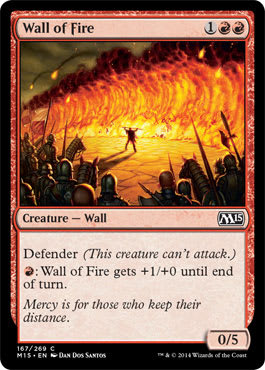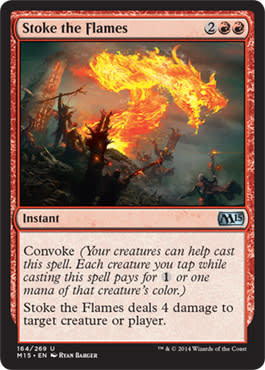It’s 1:30 A.M. Sunday night/Monday morning. You’re leaning against the cold glass in the back seat of a car barreling down the interstate at eighty miles per hour with your eyes closed. After a weekend filled with disappointing finishes and some poor draws, you’re out almost $250 and have nothing to show for it.
With three hours to go in the trip, eight hours until you have to wake up for work, and a twelve-hour work shift, tomorrow is looking particularly horrid. Burying your earbuds as far in to your head as they’ll go, you turn up the volume and hope that The Church’s “Under the Milky Way” will help you get a bit of shuteye before the D-Day that is your Monday.
As you start to drift off, you can’t help but question, “Why do I even come to these things?”
If you search for “the fire” on Google, you won’t find very much about Magic. Lyrics for a song by The Roots (with John Legend), a book on World War II–era Germany, and episodes of various sitcoms litter the search results without actually telling anyone about the fire or what it is (in relation to Magic).
The fire is a slang term for the drive to succeed in Magic. Success doesn’t always mean tournament results either. When a Magic writer says he or she “has the fire,” it means he or she is going to go out of his or her way (more so than he or she normally would) to play more Magic or have a stronger desire to do well. This can manifest itself in different ways and can yield good or bad results.
To draw from personal experience, making the commitment to travel to all of the Star City Games Tour events is simultaneously one of the best and worst decisions I’ve made in my entire life. Watching SCG Live on Twitch makes the grind seem so easy. The same faces are finishing in the cash every week or so, and there are smiling faces all around—it’s great!
In reality, the “grinder life” is significantly more stressful than most participants would like to admit, devolving to a cyclical series of restless nights, endless playtesting, sleeping in cars, and fast food.
They don’t call it a grind for nothing.
Being on the road all the time definitely has counterbalances that make it all worth it. There’s a sense of camaraderie with other people who have made similar resolutions and have also put their shoulders to the plow without any promise for success or payoff. It is through these bonds that people build all kinds of relationships based in empathy for things that most people cannot understand. Everything in life is generally going to have an overall sense of give and take, and that theme was exacerbated in Indianapolis this past weekend.
Despite a lack of confidence in my deck choice and an overall sense of anxiety, I had one last fling with Rally the Ancestors before it rotated:
Rally the Ancestors ? Oath of the Gatewatch Standard | Emma Handy, Standard, SCG Tour Indianapolis
- Creatures (28)
- 2 Sidisi's Faithful
- 4 Catacomb Sifter
- 4 Elvish Visionary
- 4 Nantuko Husk
- 4 Reflector Mage
- 4 Zulaport Cutthroat
- 2 Ayli, Eternal Pilgrim
- 4 Jace, Vryn's Prodigy
- Spells (8)
- 4 Collected Company
- 4 Rally the Ancestors
- Lands (24)
- 1 Forest
- 1 Island
- 1 Plains
- 1 Swamp
- 2 Canopy Vista
- 2 Evolving Wilds
- 2 Prairie Stream
- 2 Sunken Hollow
- 4 Flooded Strand
- 4 Polluted Delta
- 4 Windswept Heath
- Sideboard (15)
- 2 Murderous Cut
- 1 Fleshbag Marauder
- 1 Merciless Executioner
- 1 Minister of Pain
- 1 Kalitas, Traitor of Ghet
- 2 Anafenza, The Foremost
- 1 Hallowed Moonlight
- 2 Dispel
- 2 Duress
- 2 Exert Influence
The list was relatively unexciting, with some slants toward the mirror and Mardu Green decks that I expected to make up a reasonable portion of the tournament. After a tough-fought loss to Michael Majors and some mana problems, my tournament was cut short by Round 8, and I was registering a Legacy deck for the next day.
To talk about the handful of changes I made to the deck going into this weekend that may raise a few eyebrows, I’ll start off with the copies of Exert Influence. They stick out a bit from the list and hadn’t made it to the spotlight outside of some talk from Jarvis Yu and Ari Lax on Twitter.
Exert Influence is at its best against the various flavors of Siege Rhino decks that are bound to show up. The ideal usage is stealing an Anafenza, the Foremost or Kalitas, Traitor of Ghet. The Mardu Green decks that load up on these styles of effects have ways to recur their creatures if you use something like a Murderous Cut or a Fleshbag Marauder–style effect to deal with the creature in question. If you have a window to successfully steal the creature, it puts the opponent in a position that requires him or her to kill the creature before recurring it with Den Protector, Kolaghan's Command, or Pulse of Murasa. The idea is that this puts the opponent far enough behind that the Rally player can close out the game before the Mardu player can stabilize with the creature on the battlefield again. Exert Influence is particularly powerful in conjunction with Jace, Vryn's Prodigy. Most Mind Control effects are enchantments that remain on the battlefield, but Exert Influence can be recast with Jace, Telepath Unbound’s -3 ability to steal another creature the very next turn.
The split between Anafenza and Kalitas was an attempt to have some respect for Reflector Mage out of Rally the Ancestors decks by diversifying the names of the graveyard-hate creatures the deck had access to. Having the single copy of Hallowed Moonlight may have been counterproductive, and truthfully, it should’ve just been in a Dispel in hindsight. It’s great being able to “get ’em” when the opponent isn’t expecting it, but the tempo difference between having to hold up a single blue mana or a white mana and 1 generic mana is enormous. Hallowed Moonlight also doesn’t have the ability to be offensive in the way that Dispel does (countering other Dispels in the mirror for example) and is a major strike against it.
The shaved Evolving Wilds for the sixth Battle for Zendikar dual was a concession to the higher curve out of the sideboard. It wasn’t actually an increase in the number of lands, but I did want to have one more land that actually produced mana with the inclusion of two “multicolored” 5-drops and a double-black 4-drop.
Onto Sunday, I played a Burn variant in Legacy that I have been casually tuning for a few weeks to pretty reasonable success:
R/u Burn ? Legacy | Emma Handy, SCG Indianapolis Classic
- Creatures (14)
- 2 Grim Lavamancer
- 4 Delver of Secrets
- 4 Eidolon of the Great Revel
- 4 Goblin Guide
- Spells (26)
- 1 Searing Blaze
- 3 Fireblast
- 4 Lightning Bolt
- 4 Price of Progress
- 2 Gitaxian Probe
- 4 Chain Lightning
- 4 Lava Spike
- 4 Rift Bolt
- Lands (20)
- 4 Mountain
- 2 Bloodstained Mire
- 2 Volcanic Island
- 4 Arid Mesa
- 4 Scalding Tarn
- 4 Wooded Foothills
- Sideboard (15)
- 3 Ensnaring Bridge
- 4 Pyrostatic Pillar
- 1 Simian Spirit Guide
- 2 Searing Blaze
- 3 Exquisite Firecraft
- 2 Sulfuric Vortex
The title of the decklist is a bit misleading. This started out as a Burn deck that played Brainstorm and more copies of Gitaxian Probe with Flusterstorm in the ’board. The Flusterstorms were cut before SCG Louisville, and the Brainstorms were cut the week before this tournament in an effort to streamline the deck more. Delver of Secrets is generally just a fantastic upgrade to the decidedly underwhelming Monastery Swiftspear (incredibly embarrassing against our new Eldrazi overlords and cards that are good against the Eldrazi themselves) while providing an interesting mental angle of attack.
There are many games in which Burn will end up being a turn behind on the race or having to try to manage an odd tempo game early that it isn’t always prepared to fight on. There is a nonzero number of games in which leading on Wooded Foothills for Volcanic Island into Delver of Secrets looks close enough to Temur Delver that players will play around Daze, Force of Will, or Spell Pierce and be much further behind than they can afford to be against a Burn strategy.
Delver blind-transforms roughly fifty percent of the time, and that is a number I’m not quite comfortable with, but most of the list is quite tight if keeping Delver of Secrets is actually a necessity—and I suspect it isn’t.
The actual tournament was somewhat indicative of how the average Burn deck fares in tournament Legacy. Defeating the fair decks is generally elementary, and the matchups against faster combo decks are nearly unwinnable. The Simian Spirit Guide in the ’board was just in hopes of having a Pyrostatic Pillar–style effect on the battlefield on the first turn against Storm variants. I finished 5–3 in the tournament, with my losses coming at the hands of Goblin Charbelcher, Tin Fins, and Shardless Sultai. The first two losses involved me playing fewer than five total turns of Magic (between the rounds), and the Shardless Sultai games were actually quite interesting—but resulted in my finishing outside of prize contention.
Even with my poor finishes in the tournaments this weekend, it was fantastic watching teammate Robert Wright make it all the way to the finals of the Standard Open as the lone Esper Dragons player on Day 2. Their inclusion notwithstanding, this article isn’t meant to be a soapbox to lament my shortcomings or publicize my bad beats. Describing all the negative aspects of hopping from city to city each weekend is essential when it comes to explaining just how powerful the fire can be.
It’s easy to keep the fire alive when you’re adding another trophy to your mantle or you’re running to the bank to deposit a prize check addressed to you from Hasbro. Fanning the proverbial flames is much more difficult after a string of poor finishes and having the ability can be the difference between “making it” and not.
The fire isn’t always something that applies to people who are traveling six or more hours to play high-stakes Magic each weekend. For plenty of people, it just means dedicating to go to every single Friday Night Magic or Preliminary Pro Tour Qualifier in one’s area. Harnessing this drive is a crucial piece of becoming a better Magic player, and knowing it may be harmful at times is an important part of self-awareness and cost–benefit analysis in relation to attending certain events.
Keeping the fire aglow requires dedication and realism mixed with a dash of obstinacy. Drawing from my mediocre results in Indianapolis in relation to my own flame, there are plenty of reasons to Stoke the Flames (pun intended). For many people, the goal in traveling to tournaments is to win as much as possible. I tend to think much smaller and in a more localized way. When traveling to large events, my goal is to become better at Magic in the hopes that results will eventually follow. All nobility aside, this tends to affect my view on success and failure on a given weekend, as I possess an incredibly distorted lens.
The fire isn’t always results-oriented, and failing to realize this can get you burned more often than not. Keep this in mind whenever you find yourself at the end of a tournament doing worse than you thought you should have done or when you feel unfulfilled after an event. There’s always another event, and the fire is sure to get you there.


























